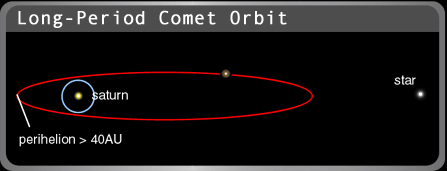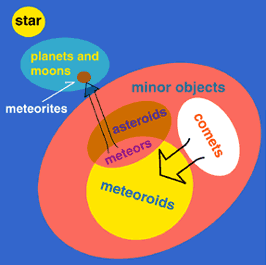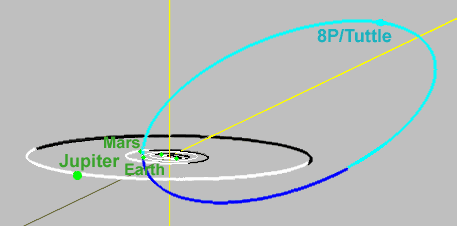
| Anatomy and Characteristics | Orbits: Type and Evolution | Comets, Meteoroids, Asteroids |
Comet Anatomy and Characteristics
The Comet Characteristics section should help students bridge the gap between the comet as dirty snowball and the bright, but slow-moving "hairy star." Although Newton himself guessed that comets' tails were "formed of minute particles that emanated from the head under the influence of solar rays," deeper knowledge awaited better understanding of the near-sun environment, much of it in this century and even post-space age.
The power of the Sun's radiation and the solar wind are what make the difference--the comet absorbs energy, mainly in the form of radiation, but also from magnetic fields. To receive enough energy from the Sun to be visible, at least with a telescope, a comet's orbit must have a perihelion of less than 5 AU. This results from orbits that are either fairly eccentric ellipses, or open orbits that only visit the Sun once. Close to the Sun also means close to the earth, our observation site. Good thing for comet watchers that we aren't on Saturn!
The main effects come from the energy of the Sun's radiation, which sublimates, the ices and heats the resulting gas. The coma develops because gas molecules that have just "boiled" off the surface have the same original speed and direction of travel as the nucleus, and so seem to "cling" to it. The gas glows, as it absorbs sunlight, heats up, and emits a spectrum of visible light corresponding to its temperature. The dust, made of silica, carbon and trace minerals and metals, reflect sunlight. What happens to these two components, the gases and dust, is determined by the different ways they interact with the near-solar environment. The "Characteristics" lesson page has more about the appearance, size, and scale of the various features.
Plasma of ions + solar wind = plasma tail
Absorption of high-energy solar radiation (light) causes some molecules in the heated gas coma to ionize: they lose one or more of their negative electrons and become positively charged. This is where the solar wind comes in. Part of the solar wind is a magnetic field, which originates deep within the Sun, and is carried outward by the protons and other positive ions escaping the solar atmosphere. The field is like the field of a bar magnet so large, that near the comet its field lines would look straight, like waves on a beach.
Because a magnetic field exerts a force on a charged particle, this solar field wave "breaks" over the comet, pulling on the ionized gas of the coma1 It sweeps away the electrons, which are much lighter, and draws the heavier ions outward, into a long plasma tail (also called an ion tail) that points in the anti-sunward direction. Detailed pictures of ion tails show they are turbulent, like the wake of a small boat in a very strong current.
The hot ions swirl around in the magnetic field; the field speeds them up, and they release the energy as light, only to absorb more from the field. But the light from the plasma tail is still faint, so ion tails are often hard to see without a telescope. Astronomical photographers often use extended exposures to catch them. You can make a simulation of a comet with ion tails using the Amazing Space comet maker* referred to on Page I. Try putting in several volatile substances like methane and ammonia and see the resulting tails.
Solar dust broom
The sublimating of the comet ices also frees dust and rocky material. Dust particles in space are subject to actual pressure from the Sun's radiation. This radiation pressure, the same effect that makes those little solar radiometers in glass globes spin round, sweeps the dust away from the nucleus, also in an anti-sunward direction. The debris still has some momentum, and it continues to orbit the Sun, but it is pushed away from the nucleus and is slowly left behind. The material forms a curved dust tail that can be very reflective. It may appear quite brilliant in the night sky when the comet is well separated from the Sun in our field of view (like a full moon). It is the long, bright dust tail that is usually the most visible. Eventually this dusty debris spreads out along the comet orbit, and becomes the material of meteor showers. Most of this material is tiny or microscopic in size.
Since both types of tails point generally anti-sunward, and a comet's orbit may be oriented at almost any angle to the earth's orbit, whether a long tail is visible from earth is a matter of chance. If the comet is nearly on the other side of the Sun, the tails will point away from (or towards) us, and be nearly invisible in the glare from the coma. So indeed, the different appearances of various comets, or even the same comet, can be deceiving.
Those looking for more about solar wind and the interplanetary environment may want to look at the reference desk of the NASA OSS Sun-Earth Connection Education Forum site at:
http://sunearth.ssl.berkeley.edu/educators/index.html (new window)
or possibly "Ask A Scientist" on the same page.
Once Halley and Newton figured out how the orbits of comets could be described, the next interesting question was why any comet has the orbit it has. As you saw in the Origins section, the formation of the Oort Cloud around the inner solar system put many comets into orbits where they no longer encounter large objects like Jupiter at close range, and are are much farther from the Sun than Pluto, even at perihelion. What caused the comets Oort originally studied to come close enough to the Sun to observe? In other words, what changed their orbits?
Oort suggested that the gravity of passing stars might exert a gravitational pull on some comets, making their orbits longer and narrower. Stars pass each other within galaxies, although they also orbit around the galactic center. Another star passing by the Sun would be a relatively common event in the course of 4.5 billion years.

(distance to the star is not drawn to scale! The star would be at least 10 light years away.)
Unlike the "Origins" animation of Jupiter flinging comets outward, this cartoon shows a passing star lengthening an orbit by the pull of a distant, but extremely massive object. The huge mass of the star makes up for the larger distance, and its gravitational pull can both bring the comet outward and make its orbit flatter (more eccentric), like someone stretching a rubber band. When the star passes, the new orbit remains.
The more stretched-out an ellipse becomes, the closer the focus points are to the ends. This means the longer and flatter a comet's orbit becomes, the closer it is to the Sun at its perihelion. If the orbit becomes narrow enough, the comet passes close enough to the Sun, and becomes bright enough, to be observed with a telescope, binoculars, or the naked eye.
How do we get to observe short period
comets, which start out in the Kuiper
Belt? Objects in the
Kuiper Belt have elliptical orbits too, and their paths may bring
them inside the orbits of the giant
planets.  If a comet crosses a planet's orbit near where the planet
happens to be, the planet can pull it into an orbit inside
the solar system. This is like the way stars alter the
orbits of long period comets, but on a much smaller scale. Note in
the illustration at left that the comet's original (open) path would have brought it
closer to the Sun, but only once! On the closed elliptical orbit, it will
keep returning until its motion is perturbed again.
If a comet crosses a planet's orbit near where the planet
happens to be, the planet can pull it into an orbit inside
the solar system. This is like the way stars alter the
orbits of long period comets, but on a much smaller scale. Note in
the illustration at left that the comet's original (open) path would have brought it
closer to the Sun, but only once! On the closed elliptical orbit, it will
keep returning until its motion is perturbed again.
One thing about comets is that many travel in orbits at large angles to the ecliptic, the plane of the earth's orbit around the Sun. The ecliptic is used as a good approximation to the plane of the other planets, with the exception of Pluto, which is suspected of being a large Kuiper Belt object, rather than a true planet.2
|
|
| This diagram shows the orbit of comet Tuttle, which is in a plane almost perpendicular to the orbits of the planets and has its perihelion just inside Earth's orbit. |
Comets, Meteoroids, Asteroids: the Interplanetary Zoo
It's common for students to have confusion about comets vs. asteroids, vs. meteors, meteoroids, and meteorites. The term meteor was probably coined to describe visible "shooting stars" long before the origin of meteors was known. Comets and asteroids both formed in the early development of the solar systems. Asteroids, most of which orbit between Mars and Jupiter, are thought to be a bit older. This is because metals, carbon, and silicon became solid at higher temperatures than the gases that make up most of comets, and so they solidified earlier (see also the section on the relative ages of Kuiper and Oort comets in Page I; the idea is the same.)
Comets are the main source of meteoroids, which they release as dust and rocky material near the Sun (this term is also used by some to denote any small body near the earth). Most of this material is the size of sand grains, or smaller. The Educator's Guide to Micrometeorites contains a good short summary on the relationships of all the "meteo" family of objects. The "ite" suffix in meteorite is common in names for terrestrial rocks like granite and calcite, as opposed to space objects, like meteoroids, which have the "oid" suffix.
Objects in the solar system
|
Here is a diagram showing various kinds of objects in the solar system as subsets, or contributors to, other kinds. The labeled groups are not scaled by mass or number, although there are certainly far more minor objects than stars, planets and moons. The group of "Comets" includes icy bodies in both the Kuiper Belt and Oort Cloud. The non-gaseous material that leaves comets enters the class of meteoroids. Both meteoroids and asteroids can contribute to the class of meteors (things that enter the atmosphere). Meteorites have become part of a planet like Earth, or a moon. Some astronomers even watch for meteorite impacts on our moon during meteor showers.
| Anatomy and Characteristics | Orbits: type and evolution | Comets, Meteoroids, Asteroids |
![]()
1 The solar field affects the earth in a similar way, producing a large "bow shock", but Earth has a strong magnetic field of its own that excludes the solar field and protects the earth.
2See an interesting discussion of what size object qualifies as a planet: "The Physics Teacher," vol. 38, No. 9 (December 2000), p534.
©Copyright 2000 Regents of the University of California.
